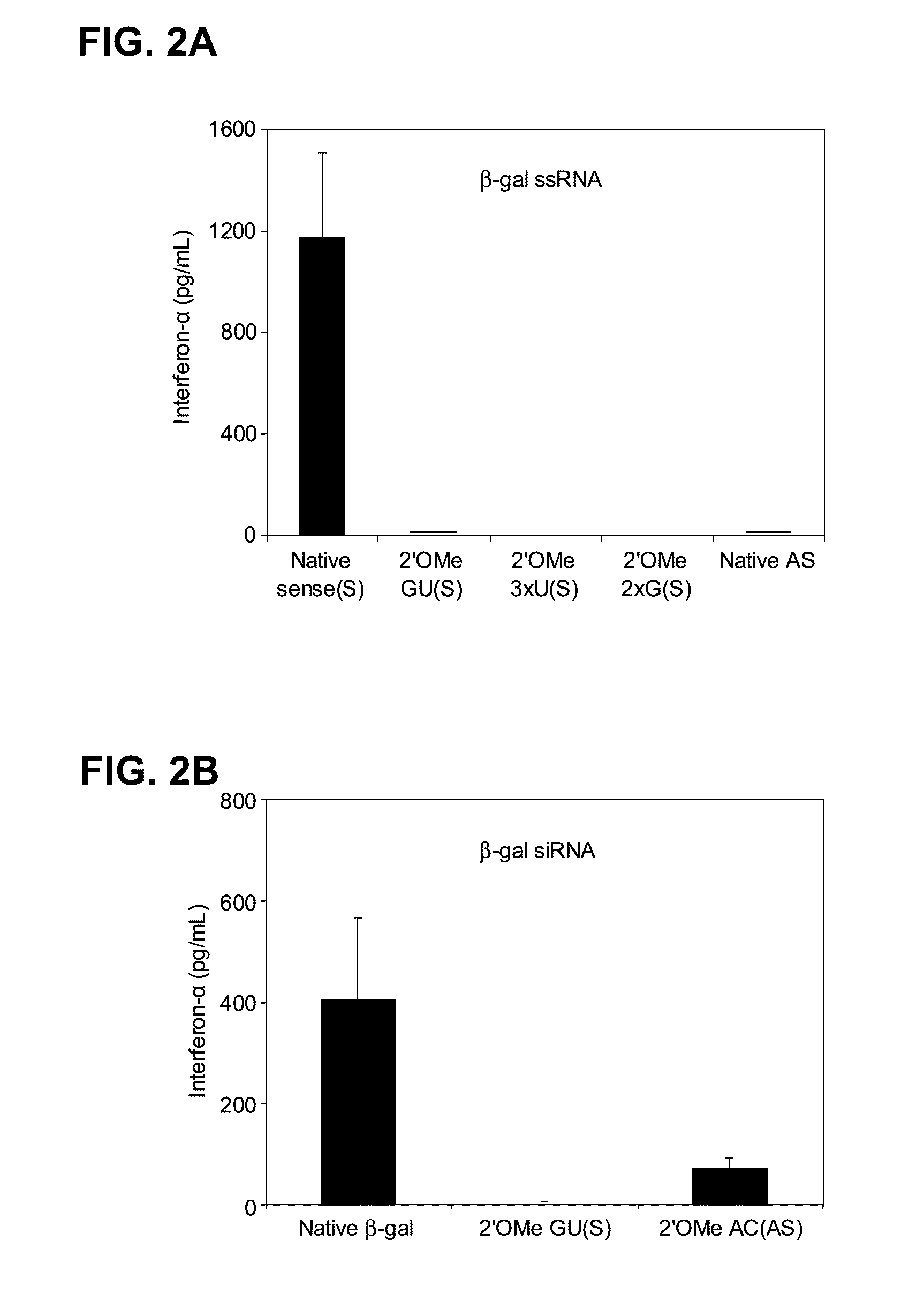MODIFIED siRNA MOLECULES AND USES THEREOF
a technology of sirna and sirna, which is applied in the field of modified sirna molecules, can solve the problems of compromising the potency of rnai-mediated gene silencing, severe activation response, toxic shock-like syndrome, etc., and achieves the effect of reducing or completely abrogating the immunostimulatory activity of sirna, and reducing the immunostimulatory properties of sirna
- Summary
- Abstract
- Description
- Claims
- Application Information
AI Technical Summary
Benefits of technology
Problems solved by technology
Method used
Image
Examples
example 1
Design of Non-inflammatory Synthetic siRNA Mediating Potent Gene Silencing In Vivo
[0294]This example illustrates that minimal 2′-O-methyl (2′OMe) modifications at selective positions in one strand of the siRNA duplex are sufficient to reduce or completely abrogate the immunostimulatory activity of siRNA, irrespective of its sequence. In fact, by restricting 2′OMe modifications to the non-targeting sense strand of the siRNA duplex, the immunostimulatory activity of siRNA can be abolished while retaining full RNAi activity.
Results
[0295]2′OMe modifications within ssRNA abrogate immune stimulation. To examine the extent and type of chemical modification required to inhibit immune cell activation by RNA, 2′OMe nucleotides were selectively introduced into the GU-rich immunostimulatory motif of a single-stranded RNA polynucleotide (ssRNA) derived from a β-galactosidase (β-gal) siRNA (Judge et al., Nat. Biotechnol., 23:457-462 (2005)). Polynucleotide sequences used in this study are provide...
example 2
Design of ApoB siRNA with Selective Chemical Modifications
[0320]This example illustrates that minimal 2′OMe modifications at selective positions in the sense and antisense strands of the ApoB siRNA duplex are sufficient to decrease the immunostimulatory properties of ApoB siRNA while retaining RNAi activity. In particular, selective 2′OMe-uridine and / or 2′OMe-guanosine modifications at less than about 30% of the nucleotide positions in both strands provide ApoB siRNA with a desirable combination of silencing and non-immunostimulatory properties.
Results
[0321]A female BALB / c mouse model was used to determine the efficacy and toxicity profiles of SNALP formulations comprising ApoB siRNA with selective chemical modifications in the sense and antisense strands. The ApoB siRNA duplexes used in this study are provided in Table 3.
TABLE 3siRINA duplexes comprising sense and antisense ApoB RNA polynucleotides.% 2′OMe-% Modified inPositionModificationApoB siRNA sequenceModified DS Region10048 ...
example 3
Design of Eg5 siRNA with Selective Chemical Modifications
[0329]This example illustrates that minimal 2′OMe modifications at selective positions in the sense and / or antisense strands of the Eg5 siRNA duplex are sufficient to decrease the immunostimulatory properties of Eg5 siRNA while retaining RNAi activity. In particular, selective 2′OMe-uridine and / or 2′OMe-guanosine modifications at less than about 20% of the nucleotide positions in one or both strands provide Eg5 siRNA with a desirable combination of silencing and non-immunostimulatory properties.
Results
[0330]Selective modifications to Eg5 siRNA retain anti-proliferative activity. A panel of 2′OMe-modified Eg5 siRNA molecules was prepared and their RNAi activity evaluated in human HeLa cells and mouse Neuro2A cells. The Eg5 siRNA duplexes used in this study are provided in Table 5. The modifications involved introducing 2′OMe-uridine and / or 2′OMe-guanosine at selected positions in the sense and / or antisense strand of the Eg5 226...
PUM
| Property | Measurement | Unit |
|---|---|---|
| mol % | aaaaa | aaaaa |
| mol % | aaaaa | aaaaa |
| mol % | aaaaa | aaaaa |
Abstract
Description
Claims
Application Information
 Login to View More
Login to View More - R&D
- Intellectual Property
- Life Sciences
- Materials
- Tech Scout
- Unparalleled Data Quality
- Higher Quality Content
- 60% Fewer Hallucinations
Browse by: Latest US Patents, China's latest patents, Technical Efficacy Thesaurus, Application Domain, Technology Topic, Popular Technical Reports.
© 2025 PatSnap. All rights reserved.Legal|Privacy policy|Modern Slavery Act Transparency Statement|Sitemap|About US| Contact US: help@patsnap.com



